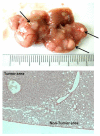Liver carcinogenesis: rodent models of hepatocarcinoma and cholangiocarcinoma
- PMID: 23177172
- PMCID: PMC3716909
- DOI: 10.1016/j.dld.2012.10.008
Liver carcinogenesis: rodent models of hepatocarcinoma and cholangiocarcinoma
Abstract
Hepatocellular carcinoma and cholangiocarcinoma are primary liver cancers, both represent a growing challenge for clinicians due to their increasing morbidity and mortality. In the last few years a number of in vivo models of hepatocellular carcinoma and cholangiocarcinoma have been developed. The study of these models is providing a significant contribution in unveiling the pathophysiology of primary liver malignancies. They are also fundamental tools to evaluate newly designed molecules to be tested as new potential therapeutic agents in a pre-clinical set. Technical aspects of each model are critical steps, and they should always be considered in order to appropriately interpret the findings of a study or its planning. The purpose of this review is to describe the technical and experimental features of the most significant rodent models, highlighting similarities or differences between the corresponding human diseases. The first part is dedicated to the discussion of models of hepatocellular carcinoma, developed using toxic agents, or through dietary or genetic manipulations. In the second we will address models of cholangiocarcinoma developed in rats or mice by toxin administration, genetic manipulation and/or bile duct incannulation or surgery. Xenograft or syngenic models are also proposed.
Copyright © 2012 Editrice Gastroenterologica Italiana S.r.l. Published by Elsevier Ltd. All rights reserved.
Figures


References
-
- El-Serag HB. Hepatocellular carcinoma. New England Journal of Medicine. 2011;365:1118–27. - PubMed
-
- Papatheodoridis GV, Lampertico P, Manolakopoulos S, et al. Incidence of hepatocellular carcinoma in chronic hepatitis B patients receiving nucleos(t)ide therapy: a systematic review. Journal of Hepatology. 2010;53:348–56. - PubMed
-
- Roncalli M, Terracciano L, Di Tommaso L, et al. Liver precancerous lesions and hepatocellular carcinoma: the histology report. Digestive and Liver Disease. 2011;43(Suppl 4):S361–72. - PubMed
-
- Alves RC, Alves D, Guz B, et al. Advanced hepatocellular carcinoma. Review of targeted molecular drugs. Annal of Hepatology. 2011;10:21–7. - PubMed
-
- Khan SA, Thomas HC, Davidson BR, et al. Cholangiocarcinoma. Lancet. 2005;366:1303–14. - PubMed
Publication types
MeSH terms
Grants and funding
LinkOut - more resources
Full Text Sources
Other Literature Sources

